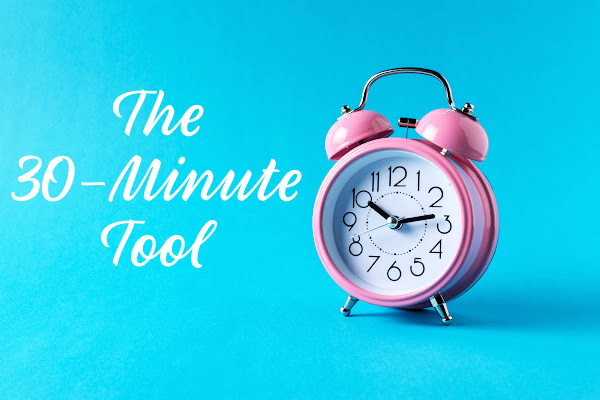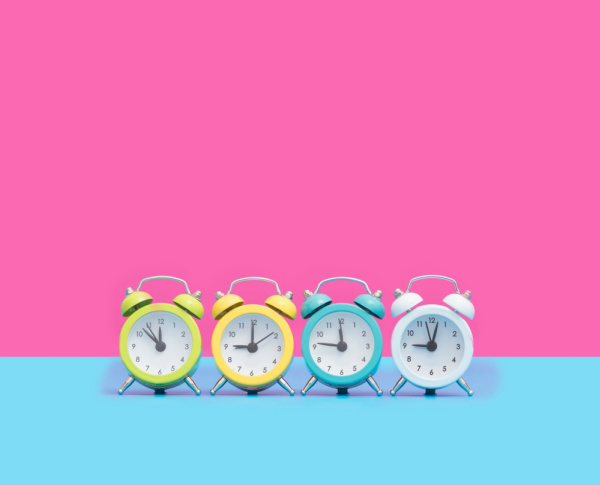Action Tool #1 – The 30-Minute Tool
We’ve been talking this month about Mindset Tools – small changes in the way you think and the way you approach making healthy changes in your life. These Mindset Tools can help you reach a goal or do something you really want to do, even if you’ve struggled in the past to make those changes. (You can find all of the Mindset Tools here.) The Mindset Tools can help you create a state of mind that supports change and help you keep going when making changes or doing something new gets tough.

Now let’s talk about Action Tools. While the Mindset Tools help you “get your mind right,” the Action Tools help you buckle down and get things done – the kinds of things that move you toward the goal or positive change you want to make. Action Tools are practical, and the first one, The 30-Minute Tool, may be the most practical of all. Here’s how it works –
What’s the one thing you really want to do? The one you’ve been thinking about, dreaming about, or planning for a really long time – but haven’t been able to accomplish. The one you’ve started and then stopped (perhaps many times), or maybe never really started.
Maybe you want to start exercising consistently, clean up your diet, or lose weight. Maybe you want to go back to school, change careers, or start a business. Maybe you want to strengthen relationship with your spouse or children. Or maybe you want to make a different healthy or positive change in your life.
You know what that one thing is for you, right? Okay, here’s an easy way to get started on it and to make some real progress – just start doing it for 30 minutes a day. That’s it, just 30 minutes a day.
I bet you’re thinking that doesn’t sound like a very useful tool, but I’m here to convince you that it’s actually one of the most useful tools in your toolbox – if your goal is to make a healthy or positive change in your life.
And even if you think that The 30-Minute Tool sounds somewhat useful, you may think you don’t have the time. And maybe you don’t – but if you really want to do the thing you’ve been wanting to do, you can find a way to make the time. And here’s an easy way to do it –
Decide to take 2 weeks, during which you’re going to find, make, or create 30 minutes a day, 6 days a week, to work on the goal or change you want to make. Two weeks is a good place to start – committing 30 minutes a day for 2 weeks will let you make real progress and start to see results. And if you absolutely can’t manage 30 minutes a day? Then start with 15 minutes.
This tool works regardless of your goal. Want to start eating healthier? Start exercising? Lose weight? Start a business? Write a book? De-clutter your house? Strengthen a relationship? Whatever it is that you really want to do, but have been putting off because you didn’t have time or felt frustrated or were afraid to try, start doing it for 30 minutes a day, 6 days a week, and keep it up for 2 weeks. Then see what’s happened.
But I’m going to spoil the surprise and tell you what will have happened. You will have made more progress than you believed possible.You’ll see positive changes that you’ve wanted to see for a long time, but weren’t sure you ever would. You’ll feel energized and ready to do more, to make more progress. You’ll feel proud of yourself for doing things you didn’t think you could do.
And you’ll be motivated to keep going.
Let’s talk about what this might look like for 3 common goals – eat healthier, start exercising regularly, and work on a big project.
Eat Healthier
Many women set a goal – often at the beginning of the year or the beginning of a season – to clean up their diet and start eating healthier. But then life swoops in and their good intentions give way to food that’s quick and easy, but not necessarily healthy.
If that’s your goal and your experience, use the Find 30 Minutes tool to get unstuck and make progress toward that goal. Here are some things you could do in 30 minutes a day over the course of two weeks that would really help you move forward –
- Clean out and organize your pantry or cabinets – It’s much easier to eat well if your pantry or cabinets are organized and stocked with the kinds of foods you want to eat. So go through and get rid of junk food, outdated food, and food you’re never going to eat – and organize the food you do want to eat in a way that you can find it quickly and easily.
- Clean out and organize your refrigerator and freezer – In the same way, get rid of food in the refrigerator and freezer that you don’t want to eat or likely will never eat. Then organize the healthy food you do want to eat so that you can find it quickly and easily.
- Plan healthy meals and snacks for the week – Look at your calendar for the upcoming week, and make a menu or meal plan that fits your schedule and your family’s schedule. Plan for quick healthy meals and grab-and-go snacks for hectic days, and meals that take a bit more time on less-hectic days. Write down your menu or meal plan and post it where you can refer to it easily.
- Make a grocery list and order groceries – Once you’ve created your meal plan for the week, make a grocery list that takes into account meals, snacks, and pantry staples you’ll need. Then, if possible, order the groceries online, for pickup or delivery, to save time and energy.
- Go through cookbooks and websites and mark or print healthy recipes you want to make – I really get tired of making the same old things all the time, and sometimes I just can’t come up with an idea for a healthy dinner. If you get stuck there too, take 30 minutes and find some healthy recipes you want to make and bookmark them or print them out, so that they’re easy to find when you need them.
- Wash and prep fruits and vegetables – One of the very best ways to make it easy to eat healthy is to prep fruits and vegetables before you need them. And it’s amazing how much prep you can get done in 30 minutes! So take that time once or twice a week to wash fruits and vegetables and cut them up and/or package them in ways that will make them easy to use during the week. For example, I always cut up vegetables for salads on the weekend – that way it’s really easy to make a healthy salad on a busy weeknight. And if fruit is washed and ready to go, it’s easy to grab it for a snack, rather than grabbing something you really don’t want to eat.
- Package healthy grab-and-go snacks or meals – Take 30 minutes and package healthy snacks for the week. And if you take your lunch to work, make 2 or 3 lunches so that you’ll be able to grab them and go on busy mornings. I always make Zesty Bean Salad on the weekend and package it to take for lunch on the days that I go to the office.
- Make or prep 2 or 3 meals – 30 minutes of meal prep can save you an amazing amount of time during the week. Look at your meal plan for the week, and figure out what you can do ahead of time. For example, you can grate cheese, chop onions, roast vegetables, grill chicken breasts, cook beef or pork in your Crockpot or Instant Pot and shred it, or put together a casserole.
- Make a master list of healthy meals you can make quickly and easily and a list of staples you need to make them – Sometimes, despite your best efforts, your day falls apart and you find yourself at dinner time with a meal plan that just isn’t going to work. When that happens, a list of simple, healthy meals that you can make with pantry staples can save your life and keep your healthy eating on track.
Each of these tasks is small, and individually they won’t make much of a difference. But collectively they can make a big difference – the difference between moving forward on your goal of eating healthier and or staying stuck in a pattern of unhealthy eating. Not only will you have made amazing progress by the end of 2 weeks, you’ll have seen results and gained momentum – making it easier to keep going.
Start Exercising
Let’s look at another goal. Say you’ve really been wanting to start exercising regularly, but just haven’t been able to make it work. Could you use The 30-Minute Tool to get on track and make progress toward that goal? Absolutely!
Here are some things you could do with 30 minutes –
- Find and organize everything you need for exercise (clothing, shoes, equipment, music, videos) and put all of it in a place where you can grab it quickly and easily.
- Go through your calendar for the week and determine where you can fit in 30 minutes of exercise each day and schedule it. If you can’t find that time, figure out what needs to change so that you can.
- Exercise! Use the 30 minutes you’ve scheduled each day to walk, bike, dance, lift weights, work out with an exercise video, or whatever you like to do – the key is to get up and move!
Work on a Project
One final example – use the tool to make progress on a project you’ve really been wanting to do. What do I mean by a “project?” It’s simply something positive you want to do that requires a concerted effort over an extended period of time. In other words, it’s the kind of thing we tend to think about and plan for, but struggle to accomplish – because it requires long-term effort, but the short-term demands of life tend to get in the way.
A project can be almost anything that meets that broad definition – like starting a side hustle, writing a book, starting a blog, de-cluttering your house, starting an Etsy shop, or learning a new skill or hobby.
Working on a project is the way I’ve used The 30-Minute Tool most recently. During COVID, I got completely off track with my blog and other writing projects – they were just languishing, even though I really wanted to restart them. I thought about them for months, made a few half-hearted starts, but really didn’t get anywhere.
So I started taking 30 minutes a day, 6 days a week to simply work on my blog or a writing project. I literally set a timer for 30 minutes every day and made myself do it, even when it felt awkward or annoying or unproductive.
I’ve done this for several months now, and am amazed at how much I’ve gotten done. I’ve written or updated a dozen blog posts, drafted a big writing project I’ve been avoiding for a year, and organized and updated a lot of content here on The Healthy Life Toolbox and on CalmHealthySexy.
But perhaps even more important, I’ve regained most of the energy and enthusiasm for writing that I had lost during the pandemic. Sometimes, you just have to do the work – and your excitement, enthusiasm, and productivity will follow!
In addition, as you work on your project, you’ll start to think more clearly about what form it should take and how you should proceed with it. Author and podcaster Cathy Heller often says that “clarity comes through action,” and she’s absolutely right about that. If your project seems vague or confusing or you sometimes wonder if it’s a stupid idea, start working on it for 30 minutes a day! As you work – even if your efforts feel pointless – over time you’ll begin to get a clearer picture of what you should do.
Use the Tool – This week, identify the one thing you really want to do but haven’t been able to do – for whatever reason. If more than one goal or project falls into that category, pick the one that’s been on your mind for a long time, the one that scares you the most, or the one you know will make the biggest difference in your life.
Then make a plan to work on that goal or project for 30 minutes a day, 6 days a week, for the next 2 weeks. Figure out how you’re going to find that time, and put it on your schedule. (Somethings that are less important may need to come off your schedule!) Then do it – set a timer for 30 minutes each day and just work on it. When the timer goes off, stop. Then do the same the next day.
You can do this any time of the day – early in the morning, during lunch at your office, during your children’s nap time, in the evening when things have quieted down – or any time that works for you.
At the end of the 2 weeks, see where you are and how you feel. If you’ve made progress and feel energized, keep going. If you don’t, figure out why. Do you need to give it more time? Do you need to let go of something that’s getting in the way? Or do you need to revise your goal or choose a different project? Decide, make changes if necessary, go for another 2 weeks, and then reassess again.
P.S. My current approach to using this tool is to follow the 30 minutes a day/6 days a week plan, focusing on a specific goal or project, for 3 weeks in a row, then give myself a lighter week, when I only work on it 3 days for 30 minutes during the week. Then I start again, using the tool 6 days a week for 3 weeks, then 3 days a week for 1 week, then repeating the cycle. That way I get a lot done and make progress, but it doesn’t feel like a heavy burden because I know that a break is coming. I initially tried doing 3 weeks on and 1 week off, but I found that the 1 week when I wasn’t doing anything on my project often expanded to 2 or even 3 weeks off – it was hard to get back on track!







